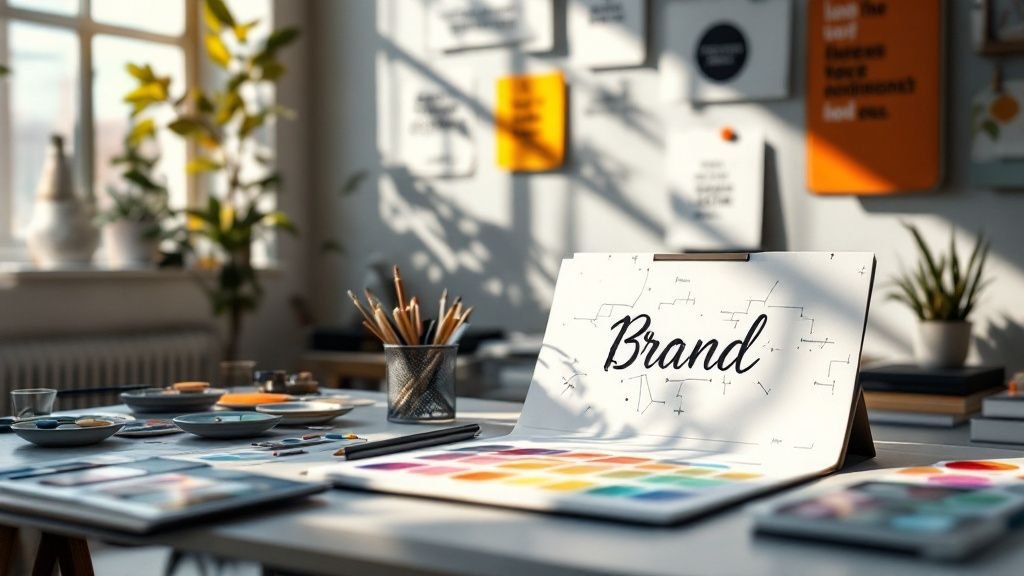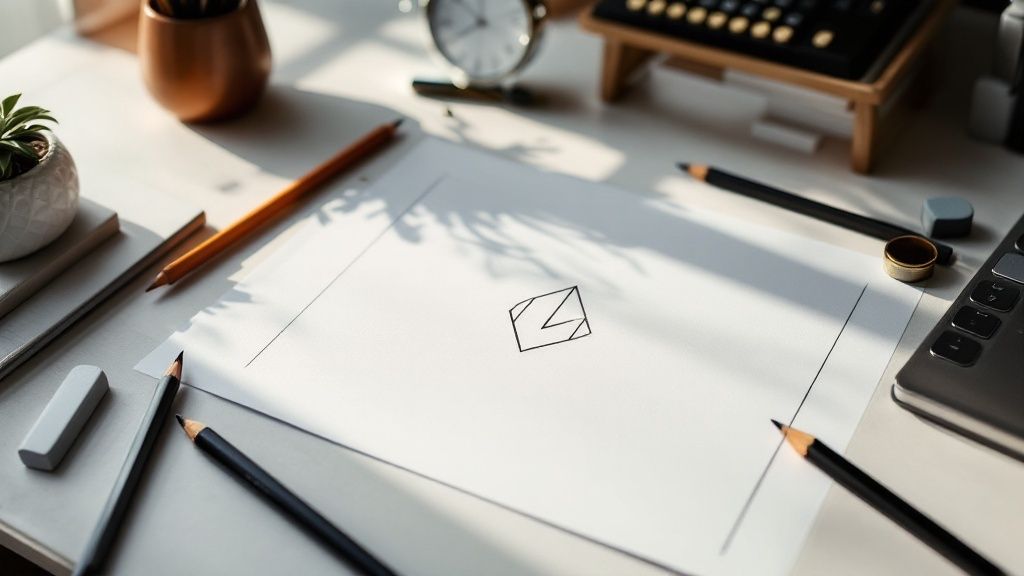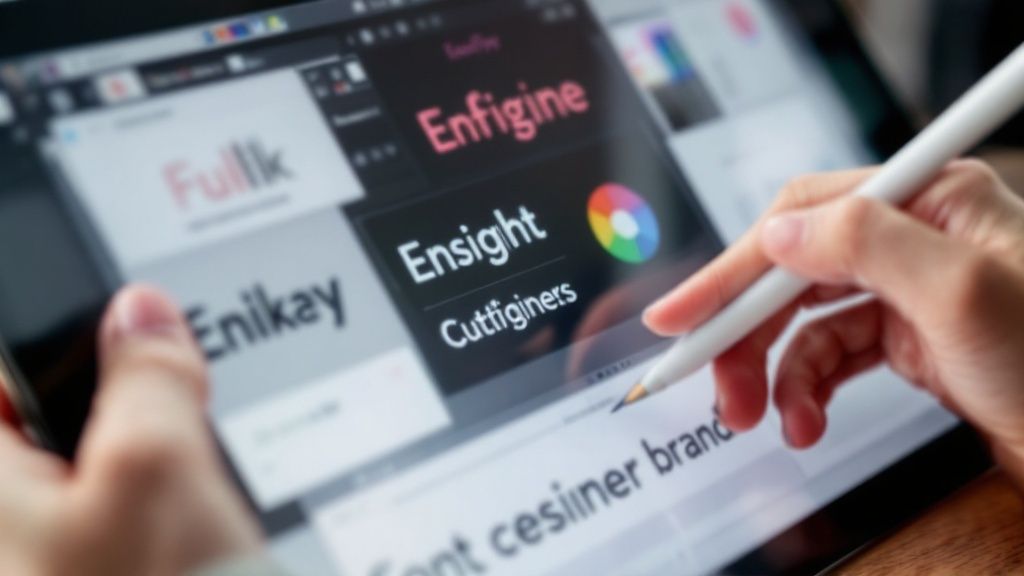
How to Create a Personal Brand Logo That Makes a Lasting Impact
Understanding Personal Brand Logo Fundamentals

A personal brand logo is the heart of your professional identity. It creates that crucial first impression and serves as a visual ambassador for your values and work. Getting the fundamentals right is essential for building a memorable and effective personal brand.
The Psychology of Visual Identity
Your logo’s visual elements directly impact how people perceive your brand. Each design choice – from colors to shapes to fonts – triggers specific emotional responses. Clean lines might signal precision and professionalism, while organic shapes can convey creativity and warmth. Making intentional design choices helps align your logo with your desired brand image.
Building Recognition and Trust
A well-designed logo is key to building brand recognition and credibility. When you use consistent visuals across your online profiles and materials, people quickly learn to recognize and remember you. Research shows that 80% of thoughtfully designed logos have enduring impact, while professional logo design can boost consumer trust by 75%. Learn more about the impact of logo design at linearity.io.
The Power of Differentiation
Having a logo isn’t enough – it needs to help you stand out. Your personal brand logo should capture what makes you unique and valuable. Think of it as visual shorthand that instantly communicates your strengths and specialties to your target audience.
Balancing Professionalism and Personality
The best personal brand logos strike the right balance between polish and authenticity. While maintaining a professional look is important, incorporating elements of your personality makes your logo more engaging and memorable. This could mean using a meaningful symbol, distinctive colors, or custom typography that reflects your style. Finding this sweet spot helps you build deeper connections while maintaining credibility in your field.
Essential Elements of a Personal Brand Logo

A memorable personal brand logo needs careful attention to design fundamentals and psychology. When key elements like typography, color, and spacing work together effectively, they tell your professional story while maintaining your unique identity. Getting this balance right is essential for creating a logo that connects with your audience.
Typography and Its Psychological Impact
The fonts you choose do more than just look good – they communicate specific qualities about your brand. Serif fonts tend to project reliability and tradition, making them popular in professional services like law firms. In contrast, sans-serif fonts give off a more modern and friendly vibe, which is why tech companies often use them. Your choice of typography can either strengthen or weaken your brand’s message.
Color Combinations and Their Emotional Resonance
Colors shape how people feel about your brand. Take blue for example – it often makes people feel calm and helps build trust, which is why many established brands use it. Red can add energy and excitement, but needs to be used carefully to avoid overwhelming viewers. Pick colors that match your brand’s core values to build stronger connections with your target audience.
Incorporating Personal Storytelling
Adding elements from your own journey helps make your logo authentic and memorable. This could be a meaningful symbol or design that represents your experiences or goals. A great example is the Apple logo – while simple, its bitten apple design carries deep personal meaning for Steve Jobs while staying clean and professional.
Framework for Evaluating Your Logo Design
Beyond just looking good, your logo needs to work strategically. Ask yourself these key questions:
- Does it communicate your brand’s main values?
- Will people remember it and recognize it among competitors?
- Can it work well across different platforms and sizes?
When you thoughtfully combine these elements in your personal brand logo, you create something that both looks professional and makes a real connection with your audience, helping establish your unique position in the market.
Designing Your Personal Brand Logo: Step-by-Step Guide
Creating a personal brand logo is an important step in building your professional identity. This guide breaks down the process into clear, actionable steps to help you develop a logo that captures your brand’s essence.
Brainstorming and Conceptualization
Start by identifying your core values and target audience. Ask yourself: What message do you want your logo to send? Who needs to connect with it? Write down keywords and visual ideas that match your brand’s personality. Consider symbols and imagery that will resonate with the people you want to reach.
Sketching and Exploration
Get out your pencil and paper (or digital tablet) and start sketching. Don’t aim for perfection – focus on exploring different creative directions. Try various shapes, lettering styles, and layouts. This hands-on process helps you discover which design elements work best together.
Refining Your Chosen Concept
Once you’ve picked your strongest concept, move to digital design. Use vector software to create clean, scalable artwork. Pay careful attention to proportions, spacing, and overall balance. Make sure your design looks good whether it’s tiny or large.
Color Palette Selection
Colors play a key role in how people perceive your brand. For instance, blue conveys trustworthiness, while green suggests growth. Research what different colors mean to your audience. Test several color combinations to find what best fits your brand’s personality.
Typography Considerations
The fonts you choose say a lot about your brand. Serif fonts often feel more traditional, while sans-serif fonts appear more modern. Test different font combinations until you find the right match for your visual style. Remember that your type choices should support your overall message.
Feedback and Iteration
Share your design with colleagues, mentors, or potential clients to get honest feedback. Listen to their input and use it to make your logo even better. This back-and-forth process ensures your final design effectively communicates your personal brand. A well-crafted logo is worth the investment – it helps you stand out and makes a lasting impression.
Tools and Resources for Personal Brand Logo Creation

You don’t need a big budget to create an eye-catching personal brand logo. There are many tools available – from basic free options to professional software – that can help you develop a strong visual identity. With some research and practice, you can find the right tools to bring your vision to life.
Free and Accessible Logo Design Platforms
If you’re just starting out or working with limited funds, several free online tools make logo creation straightforward. Canva offers an intuitive drag-and-drop interface with plenty of design elements to work with. Other options like LogoMakr and DesignEvo let you play with different fonts, icons, and colors. Just keep in mind that free tools often have restrictions on customization and file formats.
Professional Design Software for Advanced Control
When you need more design power and complete creative control, professional software is worth considering. Adobe Illustrator is the industry standard, giving you powerful vector tools to create logos that scale perfectly. Affinity Designer offers similar features at a lower price point. These tools let you fine-tune every detail of your design, from precise shapes to exact color values, helping ensure your logo is truly one-of-a-kind.
Supplementary Resources
Beyond logo design tools, there are many helpful resources to improve your creative process. Browse font collections like Google Fonts and FontPair to find typography that matches your brand’s personality. Color tools such as Coolors and Adobe Color can help you build harmonious color schemes. These details make a big difference in crafting a polished visual identity.
Combining Tools for Effective Workflows
The best approach often involves using multiple tools together strategically. You might sketch initial concepts in a free platform like Canva, then refine your chosen design in Illustrator for final production. This lets you take advantage of each tool’s strengths. It’s especially helpful when working with complex designs or preparing files for different uses. Like building anything worthwhile, creating a strong brand identity requires using the right tools at each stage of the process.
Implementing Your Personal Brand Logo Effectively

Creating a personal brand logo is just the beginning. The next critical step is integrating it seamlessly across your professional platforms. Your logo needs to work hard as your professional signature, appearing consistently wherever you have an online presence.
Maintaining Consistency Across Platforms
Just as major companies keep their branding uniform, your personal brand logo should look the same whether it’s on your website, social media, or email signature. When people see different versions of a familiar logo (imagine seeing the Nike swoosh looking different across platforms), it weakens the brand’s impact. Your logo needs to maintain its core design elements to build recognition and trust.
Adapting Your Logo for Different Media
Your logo will need to work at various sizes – from tiny social media icons to large website banners. This means creating logo variations that work well at different scales. You’ll want a simple version for small displays and a detailed version for larger formats. Having options for different background colors ensures your logo stays clear and readable everywhere it appears.
Creating Smart Logo Variations
Rather than redesigning your logo for each use case, develop a few strategic versions that keep your core design intact. Think of it like having different outfits that all reflect your style but suit different occasions. For example, create a wide version for website headers and a square one for profile pictures. This helps your logo look great across all platforms.
Developing Clear Brand Guidelines
To keep your personal brand logo looking professional, create brand guidelines – essentially a rulebook for logo usage. Include details about your logo variations, colors, fonts, and examples of proper use. These guidelines become especially important if you work with others who help manage your online presence. Having clear standards prevents confusion and keeps your brand consistent.
Meeting Technical Requirements
Different platforms need different image formats and sizes. Your guidelines should specify file requirements to avoid blurry or stretched logos. Include files in .png, .jpg, and .svg formats for maximum compatibility. For instance, you’ll want transparent .png files when placing your logo over images or videos. These technical details might seem small, but they’re crucial for maintaining a polished look that builds your personal brand.
Measuring and Evolving Your Personal Brand Logo’s Impact
After creating your personal brand logo, your journey is just beginning. Like any successful brand identity, your personal brand needs regular assessment and fine-tuning. Here’s how to measure your logo’s effectiveness and adapt it thoughtfully over time.
Tracking Brand Recognition
Brand recognition is a key measure of your logo’s success. Start by understanding how quickly people connect your logo to you and your work. Run informal polls on social media, send quick surveys to your network, or simply ask colleagues what they think of when they see your logo. Their honest feedback will show you how well your visual identity is landing.
Measuring Audience Response
Watch how people interact with your logo across different channels. Track important engagement metrics like website traffic, social media interactions, and email response rates when your logo is featured prominently. If you notice engagement dropping after making logo changes, that’s a signal to reassess your approach. Let the data guide your decisions.
Identifying Opportunities for Enhancement
Even well-designed logos can be improved. Review how your logo performs on business cards, website headers, and social profile pictures. Consider creating optimized versions for different uses if needed. Small adjustments can help your logo maintain its impact everywhere it appears.
Refreshing Your Logo While Preserving Brand Equity
Sometimes your logo needs a bigger update as your personal brand grows. But be careful to maintain the brand recognition you’ve built. Take inspiration from successful rebrands like Starbucks – they updated their look while keeping familiar elements. Avoid dramatic changes that could confuse your audience, like some failed rebrands that completely abandoned their original identity.
Adapting to Changing Market Conditions
Your industry and audience will naturally shift over time. Build flexibility into your logo while maintaining consistency. Keep an eye on design trends and what competitors are doing. Regular small refinements can help your logo stay fresh and effective without losing its core identity.
Ready to take your personal brand to the next level? Bhavik Sarkhedi & Co. provides expert guidance on personal branding and content strategy. Visit Bhavik Sarkhedi to learn how we can help you build an impactful, lasting personal brand.

